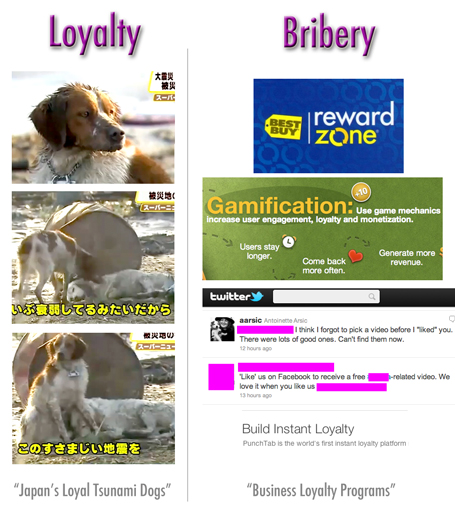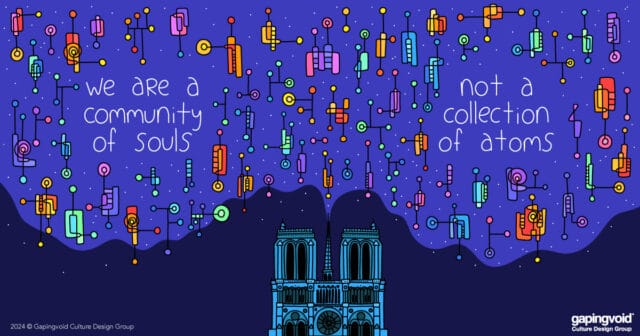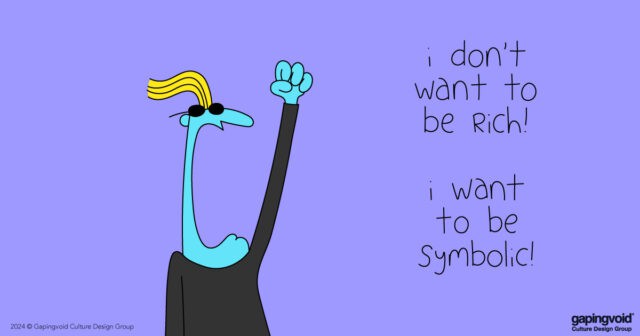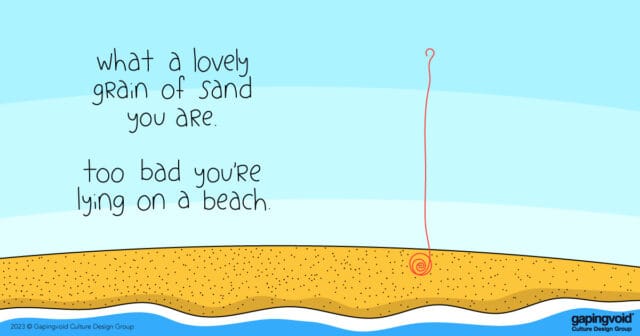Your customer won’t take a bullet for you
[Today’s guest post is from the world’s most admired ex-blogger, the great Kathy Sierra.]
“Customer Loyalty” is a figment. Business “Loyalty Programs” are nothing more than rewards-based marketing. And by rewards (aka “incentives”), I mean bribes. That we so easily refer to a customer with a bagel punch card or virtual badge as more “loyal” is an example of just how far we’ve allowed corporations to abuse the language around human relationships.
I would storm a burning building to get my kids. THAT is loyalty.
I would even storm a burning barn to get my horse.
But I won’t storm a burning Best Buy no matter how awesome their Reward Zone program.
I’m not going to become more loyal to a business no matter how well-executed their Super Awesome VIP Exclusive Content Access Status Rewards Achievements Gamification program is. Not even if Banksy made their badges.
That I often DO buy (and sometimes buy more) from the businesses that offer formal Rewards Programs does not imply I am loyal to those businesses. I’ve nothing against my wallet-full of coffee cards (which I use, and appreciate). But that is not loyalty. I’m happy to “LIKE” your Facebook page for an entry in your iPad giveaway, but that is not loyalty.
I’m willing to comment, favorite, star, plus, and potentially even share your content, but if I do it purely for the points/status/rewards, that is not loyalty. In fact, when you “incent” me to “engage” with your site, deep in my heart I understand now that I have sold out. By giving me bribes/incentives, no matter how much you call them “rewards”, you have communicated to some part of me that if I had to be incented to buy/act/engage/whatever, it must have lacked value on its own.
This de-valuing effect can be true even if the thing really DID have intrinsic value for me. In other words, even if I’d actively wanted to do the thing-you’re-bribing-me-to-do, you’ve tainted it. Possibly even wrecked it for me, even if I am not consciously aware. (See Self-Determination Theory and the Over-Justification Effect for some of the potential issues with gamification’s use of extrinsic rewards)
The darling of traditional “Loyalty Programs” is, of course, Frequent Flyer miles. But odds are most of you have taken a flight you didn’t want, on an airline you hate, thanks to a Frequent Flyer plan. When we make tough choices based on our “rewards” program, that’s not loyalty we’re feeling… it’s resentment.
A way to tell you’re heading down a dark path is to ask:
“If we took away the incentive/rewards programs, would our customers behave in exactly the same way?”
If we have to pay to get it, it’s not loyalty.
That doesn’t necessarily make it wrong to use customer incentives, but don’t mistake the results for actual loyalty.
So, how do we explain the companies, brands, products, services, etc. that we do feel fiercely loyal to? The ones that did NOT incentivize, bribe, coerce, coupon/Groupon us into choosing them over competitors? The ones we talk about to friends NOT because we get a referral bonus? Isn’t that true loyalty?
Almost. Sort of. If you tilt and angle it just so. Because I DO have a few products I appear loyal to:
I would give up my iPad for Adobe InDesign.
I would give up sleep for the latest Neil Gaiman book.
I would give up carbs for my Astund Icelandic saddle.
And I’d give up all of the above to keep using my Mac.
That sure looks, sounds, smells, quacks like loyalty.
And it is.
But it is NOT loyalty to Adobe, Gaiman, Apple, or my Icelandic saddlemaker.
I’d walk through hot coals for those because I’m loyal to… myself.
The key to understanding (and ultimately benefitting from) true “customer loyalty” is to recognize and respect that customers–as people– are deeply loyal to themselves and those they love, but not to products and brands. They are loyal to their own values and the (relatively few) people and causes they truly believe in. What looks and feels like loyalty to a product, brand, company, etc. is driven by what that product, service, brand says about who we are and what we value.
That doesn’t mean we can’t benefit from customer loyalty. The moment we stop trying to manipulate, coerce, incentivize, gamify customers into being loyal to us is the moment we free ourselves to consider how to help them where their true loyalty lies. And it starts with the deep recognition that:
If I buy from you it’s not because I like you but because I like myself.
As I said in my previous post, the key is to help users become better at something they care about. My what-looks-like-rabid-loyalty to Apple, Adobe, Gaiman, and Astund is because they have all contributed to Me Kicking Ass in a measurable, meaningful, sustainable, powerful way. Yes, even author Neil Gaiman. (His work has not just entertained and inspired me, but provided the foundation of my wedding ceremony. Long story, ‘nother time.)
If you want to benefit from a customer’s loyalty to himself, you can’t bribe it, you must earn it. Deserve it. Focus not on upgrading your product but upgrading your user’s capabilities. If you can’t enhance your product, enhance the context in which your product is used. Provide better and more inspiring documentation. Make YouTube tutorials. Join forums and offer expert help where it’s most needed. Use every nanosecond of your social media time to help people become better at something for themselves. Understand and design for Social Objects. Relentlessly ask, “How are we helping our users kick ass? What can we inspire, amplify, teach, enable, empower?”
There is always a way to help users be better at something, even if that thing seems disconnected from your product. Help them be better, smarter, stronger, funnier, more aware. Better coders, better shoppers, better parents. Better designers, better DJs, better citizens. Better puzzle-solvers, better photographers, better writers. Better joke-tellers, better conversationalists, better gardeners. Better makers, better cooks, better cartoonists. Better brainstormers, better bloggers, better runners. As Hugh once put it, “if you can’t figure this out, you’re just not being creative.”
Instead of “rewarding the customer” focus on “how can I make the user’s experience and result more rewarding”? And by “rewarding”, I mean FOR REAL. Not because of a little dopamine hit they get from earning your next virtual badge. I mean rewarding as in, “OMG look at this amazing thing I just made.” Rewarding as in, “That was one of the most stimulating conversations I’ve had.” Rewarding as in, “It’s official then. I’m bad ass. Look at the what I am now able to do that I couldn’t before…”
Of the four products I appear loyal to, none have ever given me an extrinsic reward. No punch cards, frequent-purchasing discounts, or Exclusive Access VIP Status (Now! With Better Badges!). No leaderboards, no contests, no discounts. But all have given me something far more valuable: enduringly rewarding experiences.
They have upgraded my personal skills, knowledge, and capabilities. They have made my life better. They have made ME better. THAT is the ultimate customer reward. When you give your users that, you still won’t have loyalty, but you’ll have something sustainable, robust, and honorable.
Those that understand and support the loyalty we have to ourselves are the ones to whom we write glowing unsolicited/unrewarded reviews. They’re the ones we will not STFU about in our on- and off-line conversations. They’re the ones whose logos we wear on our shirts, shorts, and car bumpers. The companies who we appear loyal to are those that best help us define, refine, and express who WE are.
[Footnote: if you do want to give an extrinsic reward to a valued customer, the most powerful, effective, and appreciated way is ALWAYS an unexpected, surprise thank-you acknowledgement (which may or may not include a valuable or symbolic gift). Rewards that are expected are perceived not as rewards but simply part of the product.]
-Kathy Sierra




